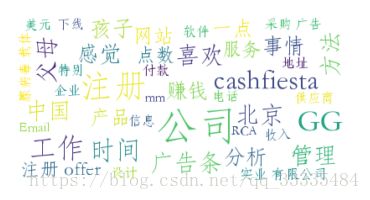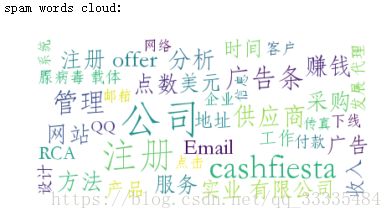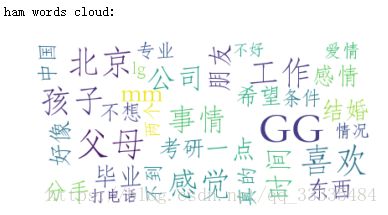使用贝叶斯方法分类中文垃圾邮件
这里的中文垃圾邮件数据集内含100条正常邮件和50条垃圾邮件,其实,这做为训练数据,是远远不够的。不过,可以先大致看一下中文垃圾邮件处理的过程。
给大家看一下数据集的基本结构,大概是这个样子的:
话不多说,上代码.
导入各种包:
%pylab inline
import matplotlib.pyplot as plt
import pandas as pd
import string
import codecs
import os
import jieba
from sklearn.feature_extraction.text import CountVectorizer
from wordcloud import WordCloud
from sklearn import naive_bayes as bayes
from sklearn.model_selection import train_test_split打开文件:
#open file
file_path = "C:\\Users\\lenovo\\Documents\\tfstudy"
emailframe = pd.read_excel(os.path.join(file_path, "chinesespam.xlsx"), 0)检查数据:
#inspect data
print("inspect top five rows:")
emailframe.head(5)print("data shape:", emailframe.shape)
print("spams in rows:", emailframe.loc[emailframe['type'] == "spam"].shape[0])
print("ham in rows:", emailframe.loc[emailframe['type'] == "ham"].shape[0])运行后得到:
可以观察到其中,垃圾邮件50条,非垃圾邮件100条。
载入停止词stopwords:
#load stopwords
stopwords = codecs.open(os.path.join(file_path, 'stopwords.txt'), 'r', 'UTF8').read().split('\r\n')
jieba分词,过滤停止词,空字符串,标点等:
#cut words and process text
processed_texts = []
for text in emailframe["text"]:
words = []
seg_list = jieba.cut(text)
for seg in seg_list:
if (seg.isalpha()) & (seg not in stopwords):
words.append(seg)
sentence = " ".join(words)
processed_texts.append(sentence)
emailframe["text"] = processed_texts查看过滤后的结果:
#inspect processed text
emailframe.head(3)
运行后可以看到:
将切词后的数据使用词云展示,观察其中规律:
#word cloud
def showWordCloud(text):
wc = WordCloud(
background_color="white",
max_words=200,
font_path="C:\\Windows\\Fonts\\STFANGSO.ttf",
min_font_size=15,
max_font_size=50,
width=400
)
wordcloud = wc.generate(text)
plt.imshow(wordcloud, interpolation="bilinear")
plt.axis("off")
#all words cloud
print("all words cloud:")
showWordCloud(" ".join(emailframe["text"]))
#spam words cloud
print("spam words cloud:")
spamtext = " ".join(emailframe[emailframe["type"] == "spam"]["text"])
showWordCloud(spamtext)
#ham words cloud
print("ham words cloud:")
spamtext = " ".join(emailframe[emailframe["type"] == "ham"]["text"])
showWordCloud(spamtext)运行后可以观察到, 全部词语组成的词云:
垃圾邮件词语组成的词云:
非垃圾邮件词语组成的词云:
可以观察到,垃圾邮件与非垃圾邮件在词语的组成上,是有区别的。
将数据转变为稀疏矩阵,以便后续的分析:
#transform text to sparse matrix
def transformTextToSparseMatrix(texts):
vectorizer = CountVectorizer(binary=False)
vectorizer.fit(texts)
#inspect vocabulary
vocabulary = vectorizer.vocabulary_
print("There are ", len(vocabulary), " word features")
vector = vectorizer.transform(texts)
result = pd.DataFrame(vector.toarray())
keys = []
values = []
for key,value in vectorizer.vocabulary_.items():
keys.append(key)
values.append(value)
df = pd.DataFrame(data = {"key" : keys, "value" : values})
colnames = df.sort_values("value")["key"].values
result.columns = colnames
return result
textmatrix = transformTextToSparseMatrix(emailframe["text"])
textmatrix.head(3)运行后可以看到:
数据集中一共有5982个不同的单词,即有5982个不同的特征。维数太多,于是接下来剔除一些频繁词汇,降低维度
#pop freq words
features = pd.DataFrame(textmatrix.apply(sum, axis=0))
extractedfeatures = [features.index[i] for i in range(features.shape[0]) if features.iloc[i, 0] > 5]
textmatrix = textmatrix[extractedfeatures]
print("There are ", textmatrix.shape[1], " word features")剔除了其中词频 > 5 的单词,运行后
![]()
只剩下544个单词,然后切分训练集和测试集
#traindate & testdata
train, test, trainlabel, testlabel = train_test_split(textmatrix, emailframe["type"], test_size = 0.2)使用朴素贝叶斯训练模型:
#train model
clf = bayes.BernoulliNB(alpha=1, binarize=True)
model = clf.fit(train, trainlabel)
最后模型评分:
#model score
model.score(test, testlabel)可以观察到评分:
代码githup下载地址:
https://github.com/freeingfree/test








